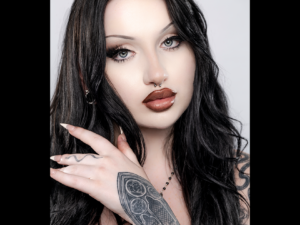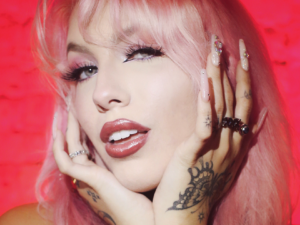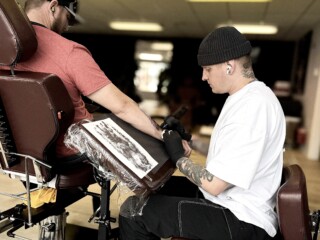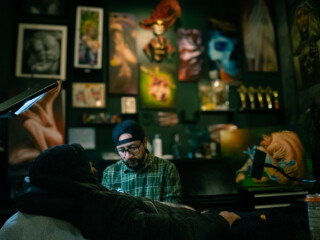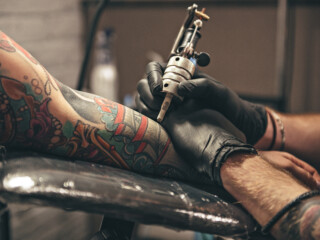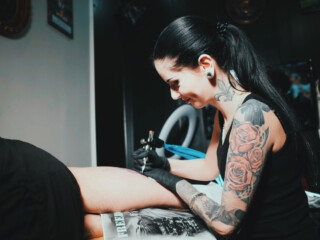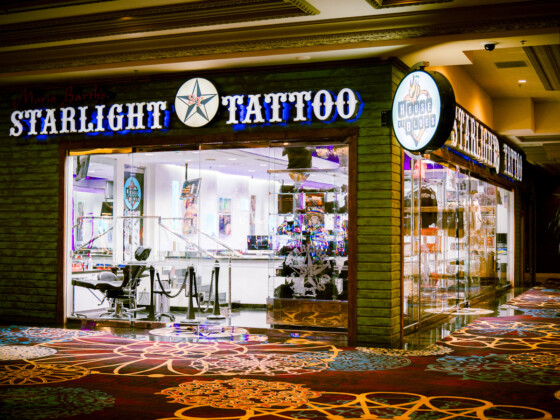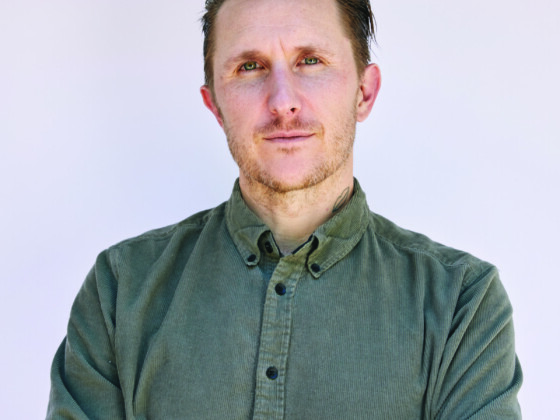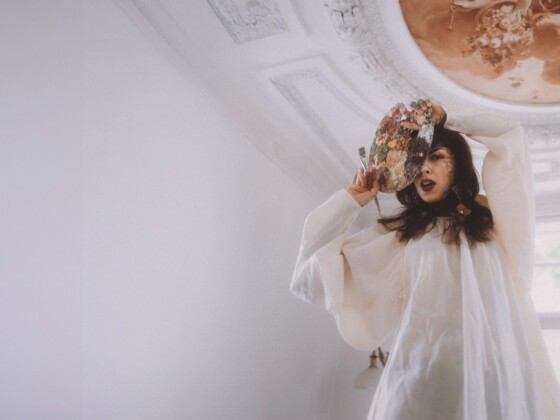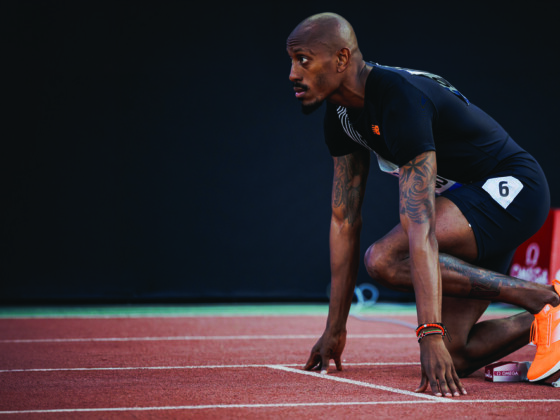Devon Preston
April 30th, 2019
20 Most Sought-After Tattoo Styles of All Time
From the past to the present, these tattoo styles continue to dominate shops around the globe
These days, there are more tattoo styles around the world than one list can properly quantify. However, for the sake of our audience, we’ve curated the top 20 most sought-after styles in one visual guide. Take a look at our list and learn a thing or two about your favorite types of tattoos.
Portraits
Over the past few years, portraits have become a staple of conventions, shops, and our Instagram feeds. A portrait is a replication of a photograph, whether that be a celebrity or a family member. The key to a good portrait tattoo, beyond the fundamentals, is an uncanny resemblance to the photograph it’s copied from. You should be able to not only recognize the person in the tattoo but see an extreme likeness to the photograph used as a reference. Some of the most prominent portrait artists working today are Steve Butcher, Nikko Hurtado, and Evan Olin.
Pin-Up
Pin-up tattoos are a staple of the industry and are most commonly created by traditional, neo-traditional, new school, and realism artists. For a tattoo to be considered pin-up, it must be a full-bodied person. This means that the artist needs to understand the proportions of a man or woman, taking into consideration details in the face and hands. Pin-up tattoos are harder than they look because they’re meant to be beautiful and it’s easy to mess up a face that’s the size of a postage stamp.
New School
Evolving out of the 1980s and 1990s, new school is one of the most prominent styles seen today. Recognized for its bright colors, wonky characters, and distorted proportions; a new school tattoo should appear to jump off the skin and blend into an animated cartoon. Some of our favorite new school artists are Timmy B, Kelly Doty, and Joe Capobianco.
Neo-Traditional
The love child of American Traditional and the art nouveau movement, neo-traditional combines bulletproof linework with elegant lady heads, animals, and florals to create head-turning designs. There are many unique variations of neo-traditional, which range from very masculine to extremely feminine. Some of the top neo-traditional artists working today include Emily Rose Murray, Matt Curzon, and Daniels Bauti.
American Traditional
Perhaps the most recognizable style on our list, American Traditional has stood the tests of time throughout the passing of trends and styles. The style came to be through pioneer Norman ‘Sailor Jerry’ Collins, pulling influence from the techniques seen by Japanese masters. Today, it continues to dominate the industry and above every other style on our list, will prevail no matter what direction tattooing takes us. Some of the most recognizable American Traditional artists are Myke Chambers, Bert Krak, and Oliver Peck.
Fine-Line
Emerging out of Los Angeles and eventually spreading to cities around the world, fine-line tattoos are one most in-demand styles today. These pieces are crafted using a single needle (or at the very least a 3 or 5) and often depict imagery of the style’s West Coast roots—Virgin Marys, payasas, praying hands, etc. Some of our favorite fine-line masters are Big Steve, Carlos Macias, and Dr. Woo.
Micro
Whether you love them or hate them, you cannot deny the impact this style has on the industry today. Thanks in part to celebrity promotion, clients are lining up in droves for tiny tattoos with big-time detail. The key to a micro tattoo is in the needle, which in many cases is a single, used to pack detail into tiny canvases. Some of our favorite micro tattooers include Mr. K, Eva Krbdk, and Dragon.
Japanese
Japanese is perhaps the oldest and most renowned style on this list, as it has been handed down by masters called Horis for hundreds of years. Today, Japanese tattooing has spread throughout the West and is highly respected throughout the industry. Traditional Japanese tattooing is done by hand and is called Tebori. However, many artists today use modern machines, which were introduced to Japan by Ed Hardy several decades ago. Today, some of the most recognizable Japanese artists are Horiyoshi III, Jess Yen, and Mike Rubendall.
Mixed Style
Within the past few years, a new style of tattooing has emerged which cohesively combines multiple genres. Mixed style tattoos can be crafted in a number of ways, whether it be realism with a traditional, new school with portraits or all of the above. The key to becoming a great mixed style artist is having the ability to execute multiple genres of tattooing and flawlessly intertwine opposing concepts into a single piece. Mixed style artists who continuously raise the bar are Yogi Barrett, Dave Paulo, Daria Pirojenko, and Chris Rigoni.
Color Realism
Color realism artists strive to create the most life-like designs possible. Many times, they are in the form of a portrait, however, realism tattoos can also be of landscapes, inanimate objects, animals, or a collage of reference photos used to create a 100 percent original piece. Color realism is one of the more difficult styles to execute, however, it’s become one of the most in-demand requests from clients around the world. Some of the most sought-after color realism artists are Nikko Hurtado, Phil Garcia, and Dmitriy Samohin.
Black-and-Grey Realism
While many might think color and black-and-grey realism are closely related, the application of these styles couldn’t be more different. Black-and-grey requires a deep understanding of the relationship between black ink and water, as most artists refrain from using grey pigments in their designs. Contrast is crucial to a black-and-grey tattoo, taking a design from looking muddy to magnificent. Some of the best black-and-grey artists around include Carlos Torres, Ralf Nonnweiler, and Victor Portugal.
Surrealism
Taking inspiration from the fine art movement of the same name, surrealism allows artists to take advantage of their imagination and create multi-dimensional designs. Surrealism as a style is fairly open to interpretation, however, some would say it’s the juxtaposition between reality and fiction. Some of our favorite surrealism artists in the industry are Sam Barber, Arlo DiCristina, and Chris Showstoppr.
Lettering
Don’t underestimate this style, because lettering is one of the baddest styles on the block. There are many different ways to go about a script tattoo, from simple fonts that can be read a mile away to ornate styles that take a second to put together. Some of our favorite lettering artists in the industry include Big Meas, Big Sleeps, and BJ Betts.
Geometric
Geometric tattooing uses the body as a canvas in a manner, unlike almost any other style. Geometric uses the organic curves of the body to create designs that, in one word, flow. Many geometric tattoos are made up of dotwork, however, some incorporate saturated blackwork or linework used to create ornate patterns. Geometric tattooers we think our readers should keep an eye on include Corey Divine, Cory Ferguson, and Chaim Machlev.
Ornamental
Ornamental tattoos take inspiration from costume jewelry and add a touch of femininity to the wearer’s body. Ornamental tattoos often include filagree, as well as jewels and gems. They can be interpreted in both color and black-and-grey, with shading used to help the primary elements of the designs pop off the skin. Some of our favorite ornamental artists include Black Casket, Ryan Ashley Malarkey, and Jenna Kerr.
Cartoon
Just like a portrait tattoo aims to replicate a photograph, these tattoos copy popular animated cartoons. From Disney to Nickelodeon to anime, these tattoos bring to life a client’s favorite character. Some of our favorite cartoon artists include Michela Bottin, Courtney Raimondi, and Kimberly Wall.
Abstract
Whoever says a tattoo needs to resemble something clearly hasn’t taken the time to admire some of the great abstract tattoos. Abstract tattoos don’t represent physical objects but use strokes, splatter, and linework to create intricate designs. These tattoos are often freehanded onto the client and allow the artist to quickly cover a large space in a short period of time. Some of our favorite abstract artists include Supreme Drone, Richard Blackstar, and Georgia Grey.
Illustrative
Like many of the styles, we’ve seen today, illustrative borrows elements from the fine art world. Illustrative tattoos are crafted to match the application techniques of painters and illustrators, such as hatching, impasto, and contouring. Some of the top illustrative artists are Stefano Alcantera, Sara Rosa, and Pony Reinhardt.
Tribal
Like Japanese, tribal has been developed for centuries within Polynesian and Pacific communities. They even gave us the word tattoo, which originates from the Samoan Tatau. Traditional tribal tattoos are passed down as a right of passage within tight-knit communities, however, we saw a spread of neo-tribal designs throughout the 1990s and early 2000s. Today, there are many artists looking to bring back the neo-tribal trend, as well as those who want to preserve the culture of traditional tribal tattooing. Some of the most prominent tribal and neo-tribal artists working today are Coen Mitchell, Javier Acero, and Jean Michel Manutea.
Blackwork
Last, but certainly not least, we have blackwork. Blackwork tattoos rely on saturated black and negative space to create bold and graphic designs with high contrast. These tattoos can be interpreted in a multitude of ways, however, they have one guiding rule—there must be plenty of black! Some of the best blackwork artists are Koldo Novella, The Black Drama, and Gena Derk.
What do you think of our tattoo style guide? Did we neglect including your favorite style on our list? Let us know your thoughts on this story in the comments section.
Editor's Picks
Chris Brown’s Face Tattoo Shows His Heart and Sole
Chris Brown has a brand new tattoo! Long gone are the days of the baby faced teen, Brown is all grown up and has the tattoo collection to prove it!…
Oh Me, Oh My
Chrissy Chlapecka on finding her voice, spreading self-love on TikTok and releasing her first single


